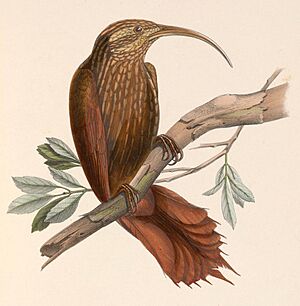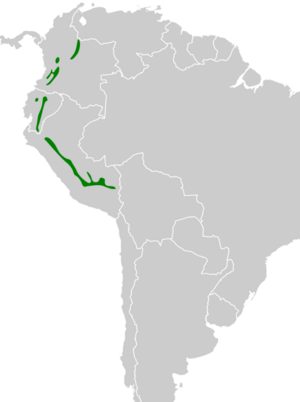Greater scythebill facts for kids
Quick facts for kids Greater scythebill |
|
|---|---|
 |
|
| Conservation status | |
| Scientific classification | |
| Genus: |
Drymotoxeres
|
| Species: |
pucheranii
|
 |
|
| Synonyms | |
|
Campylorhamphus pucherani |
|
The greater scythebill (Drymotoxeres pucheranii) is a unique Near Threatened species of songbird. It belongs to the ovenbird family called Furnariidae. You can find this bird in Colombia, Ecuador, and Peru.
Contents
About the Greater Scythebill's Family
For a long time, the greater scythebill was thought to be part of the Campylorhamphus group, which includes most other scythebills. But scientists later discovered it was more closely related to the scimitar-billed woodcreeper (Drymornis bridgesii).
Because of this discovery, a new group, or genus, called Drymotoxeres, was created just for the greater scythebill. These two birds are actually closer relatives to each other than to other scythebills or woodcreepers. The greater scythebill is the only bird in its group, and there are no different types or subspecies of it.
What Does the Greater Scythebill Look Like?
The greater scythebill is a fairly large bird, measuring about 24 to 30 cm (9.4 to 11.8 in) long. It weighs between 63 and 78 g (2.2 to 2.8 oz). It's the biggest and heaviest of all the scythebills. Unlike other scythebills, it has a shorter, thicker bill that isn't as curved.
Both male and female greater scythebills look the same. They have dark brown feathers around their ears. A clear whitish stripe runs above their eyes, and an even bolder whitish stripe is on their "mustache" area. Their upper body is a dull reddish-brown to chestnut color, with a darker top of the head.
Their head and neck have thin, light brown streaks that sometimes go down to their upper back. Their lower back, wings, and tail are a dark reddish-chestnut. Their underside is reddish-brown to chestnut, with grayish streaks on their throat, chest, and sometimes their upper belly. Their eyes are dark brown. Their bill is a dull pinkish-horn to creamy-gray, with a blackish base on the top part. Their legs and feet are brownish-gray to dark brown. Young birds are more reddish than adults and have rougher, less clear streaks.
Where the Greater Scythebill Lives
The greater scythebill is found in specific areas. You can see it in the Andes mountains of central and southwestern Colombia. It also lives on the western side of the Ecuadoran Andes, going south to the Pichincha Province. On the eastern side of the Ecuadoran Andes, it lives all the way into Peru, reaching the Department of Cuzco.
This bird prefers to live in humid montane forests, which are forests found in mountains. It likes areas from subtropical to temperate zones. It especially likes the inside of evergreen forests, cloudforests, and elfin forests. Sometimes, it can be found at the edges of forests or even in banana plantations. It lives at elevations between 900 and 3250 m (2,950 and 10,660 ft). Most often, it's found between 1000 and 3000 m (3,280 and 9,840 ft) in Colombia, and between 2000 and 2800 m (6,560 and 9,190 ft) in Ecuador and Peru.
Greater Scythebill Behavior
Movement and Daily Life
Scientists believe the greater scythebill stays in the same area all year round. It doesn't migrate to different places.
What the Greater Scythebill Eats
We don't know a lot of details about what the greater scythebill eats, but it's thought to mostly eat arthropods, which are creatures like insects and spiders. This bird is almost always seen alone. However, it often joins groups of different bird species that are feeding together. It usually looks for food in the lower and middle parts of the forest. It climbs up tree trunks and branches, picking prey from the surface and poking into cracks and moss.
Life Cycle and Reproduction
Very little is known about how the greater scythebill reproduces. We know that its breeding season includes October. The only known nest was found in a vertical hole in a living tree and held two eggs.
Greater Scythebill Sounds
The song of the greater scythebill is described as "alternating series of twitters and nasal 'ik' notes." Another person described it as "a rather weak and nasal, ascending 'ee-ee-ee-ee-ee-énh'." Its song is very different from the songs of all other scythebills.
Status of the Greater Scythebill
The IUCN (International Union for Conservation of Nature) has listed the greater scythebill as a Near Threatened species. This means it's close to becoming endangered. It lives in a small area, and we don't know its exact population size, but it's believed to be getting smaller.
This rare bird has a moderately small and broken-up living area. Its numbers are likely going down in most places because its habitat is being lost. Scientists believe the species is very sensitive to human activity in areas where forests are being cut down a lot.


